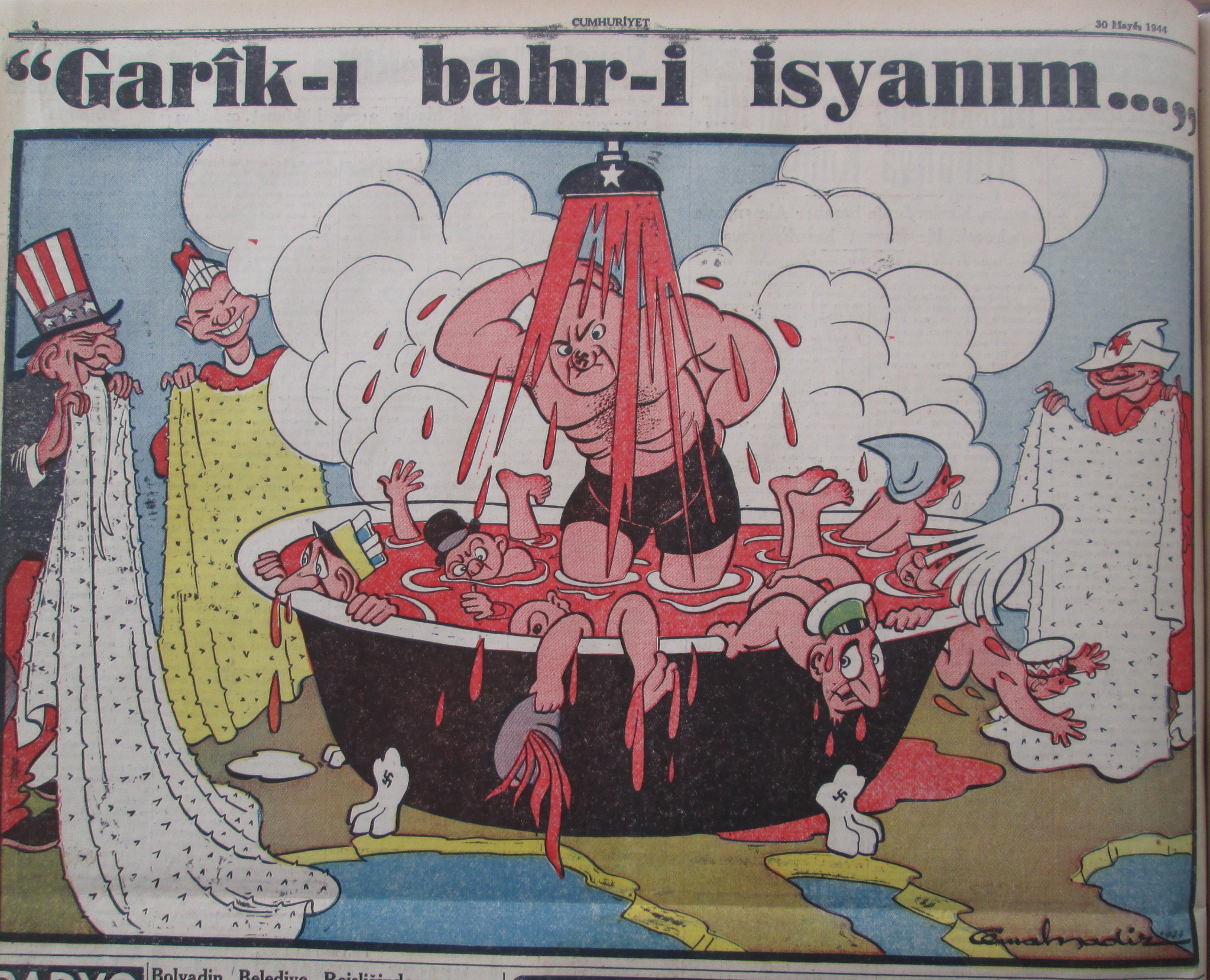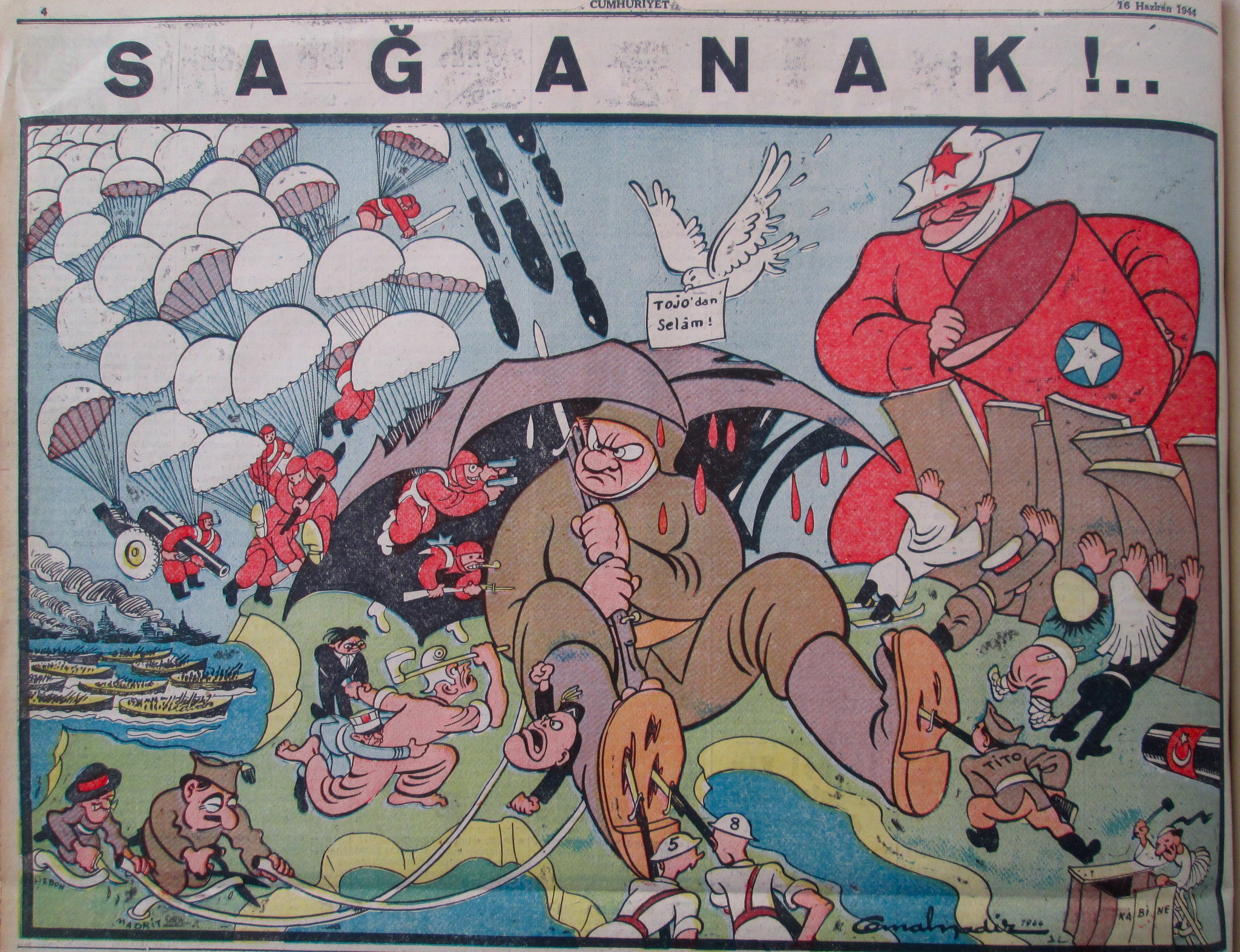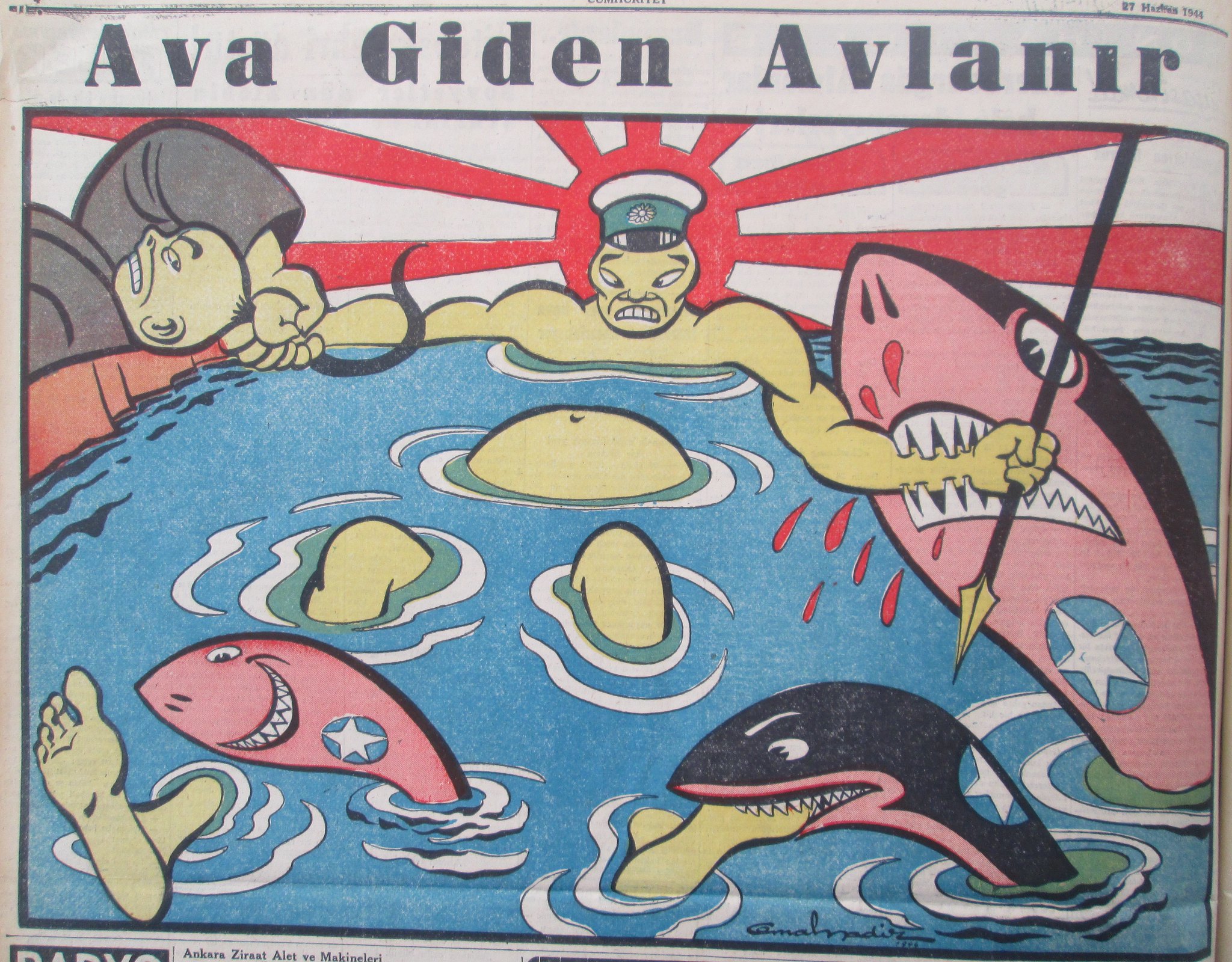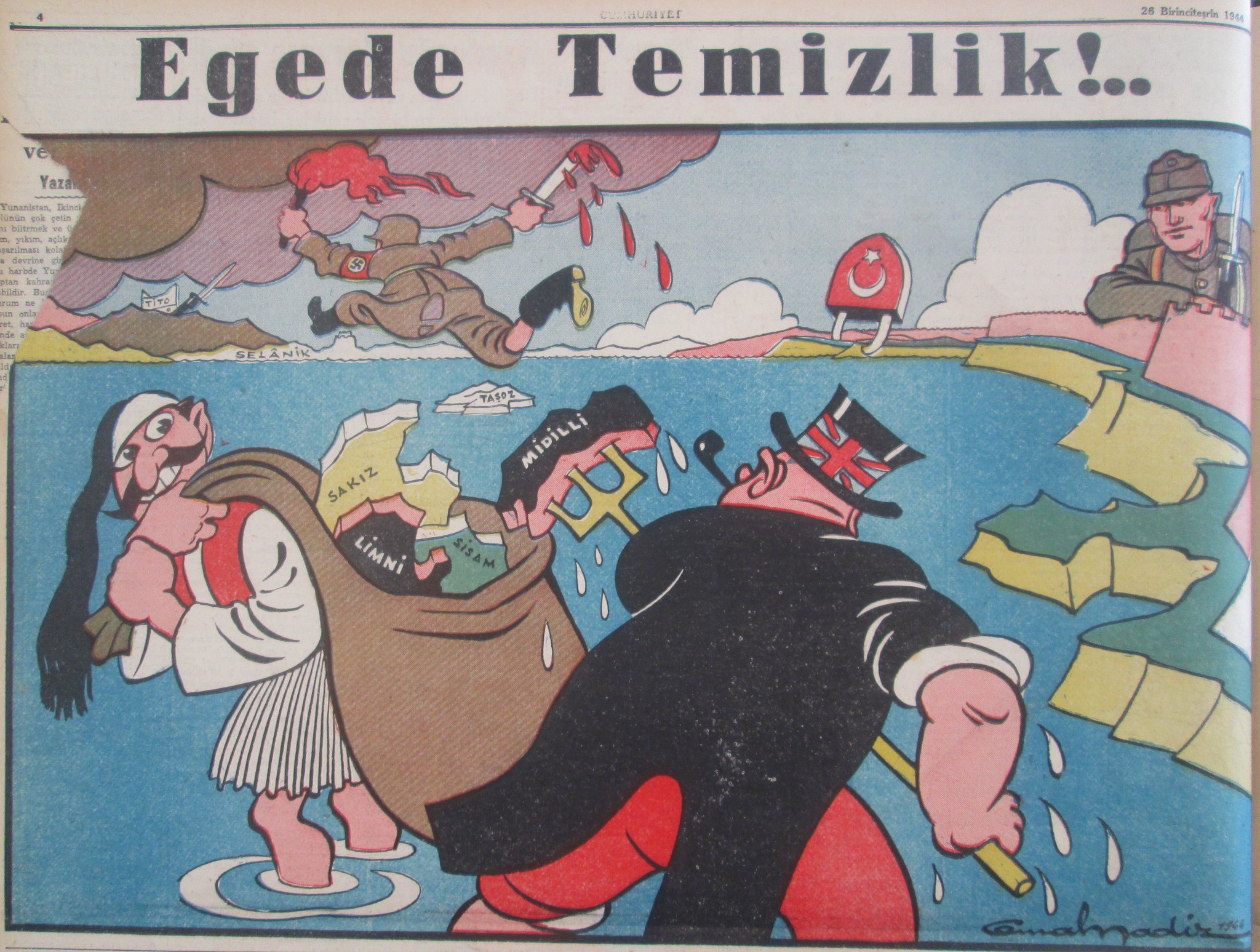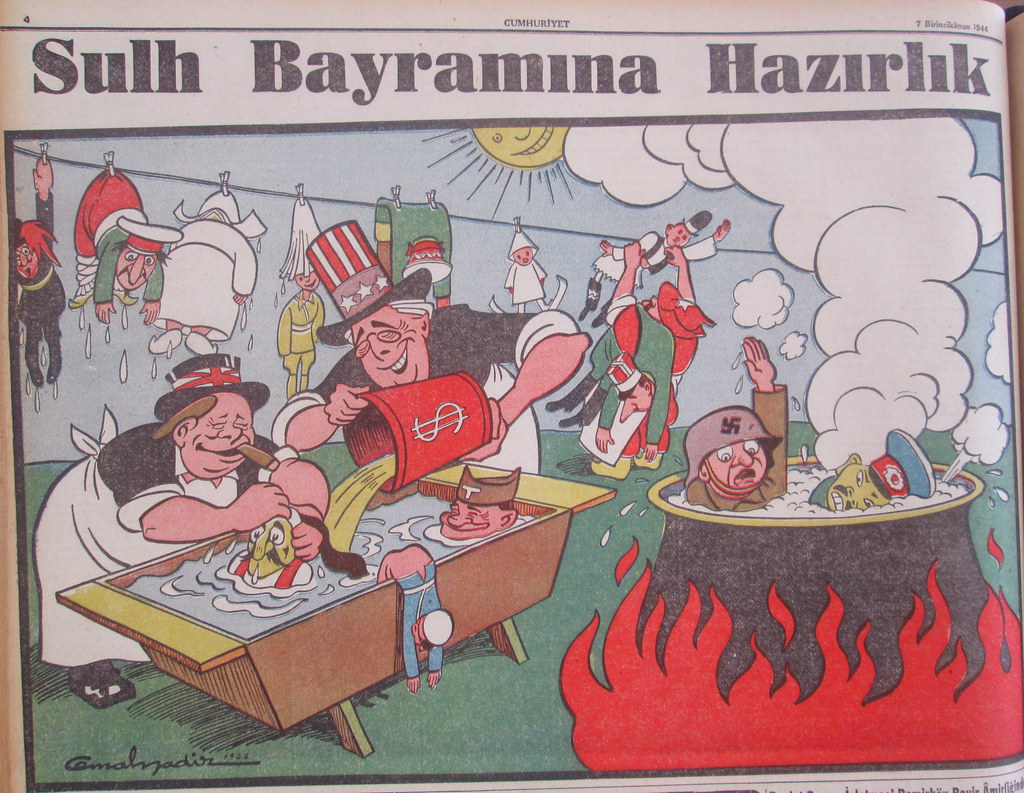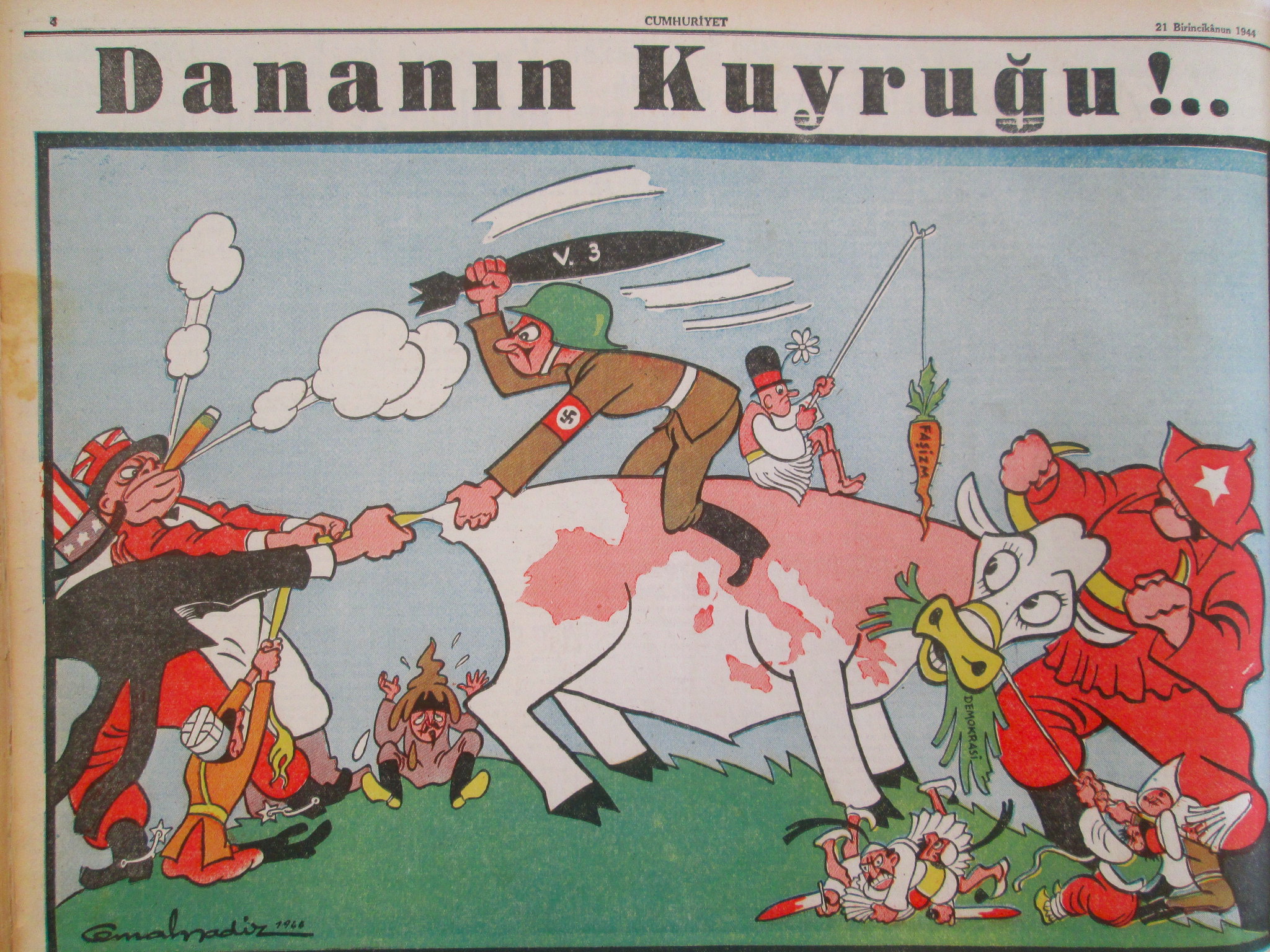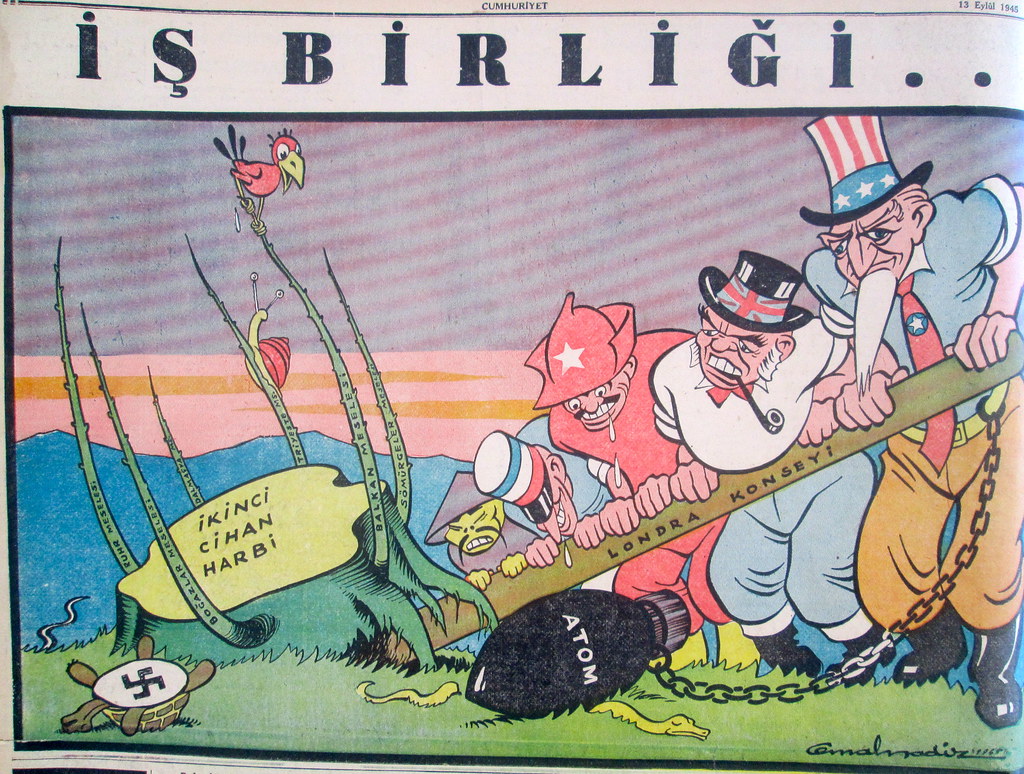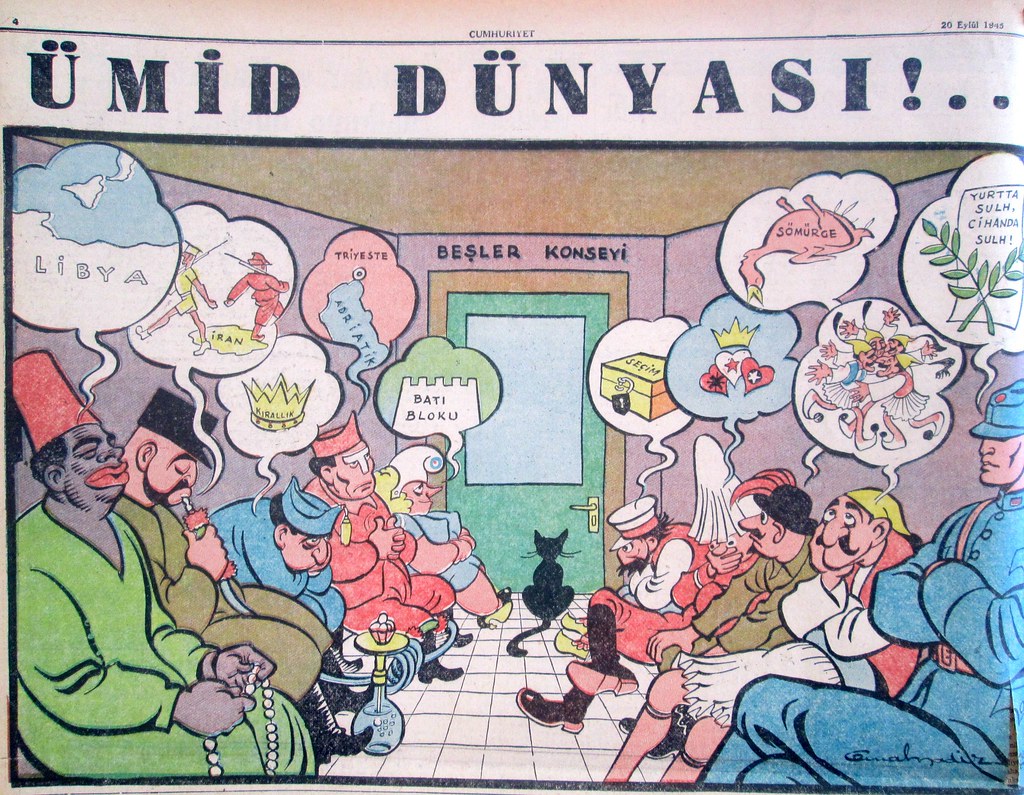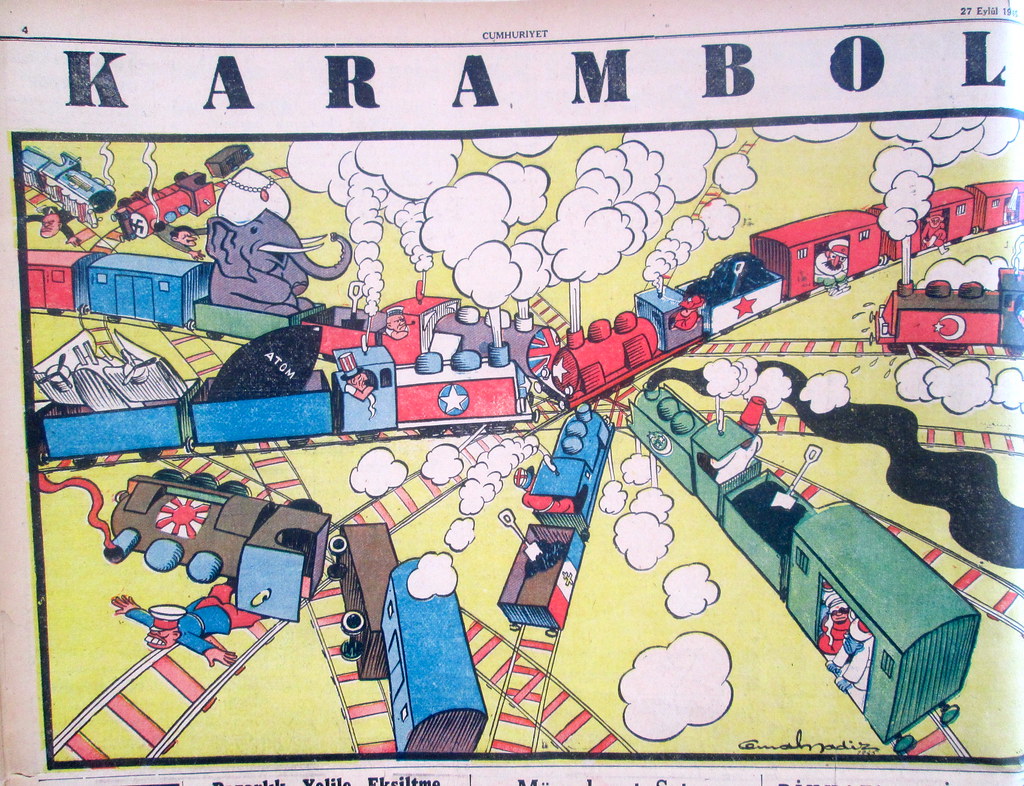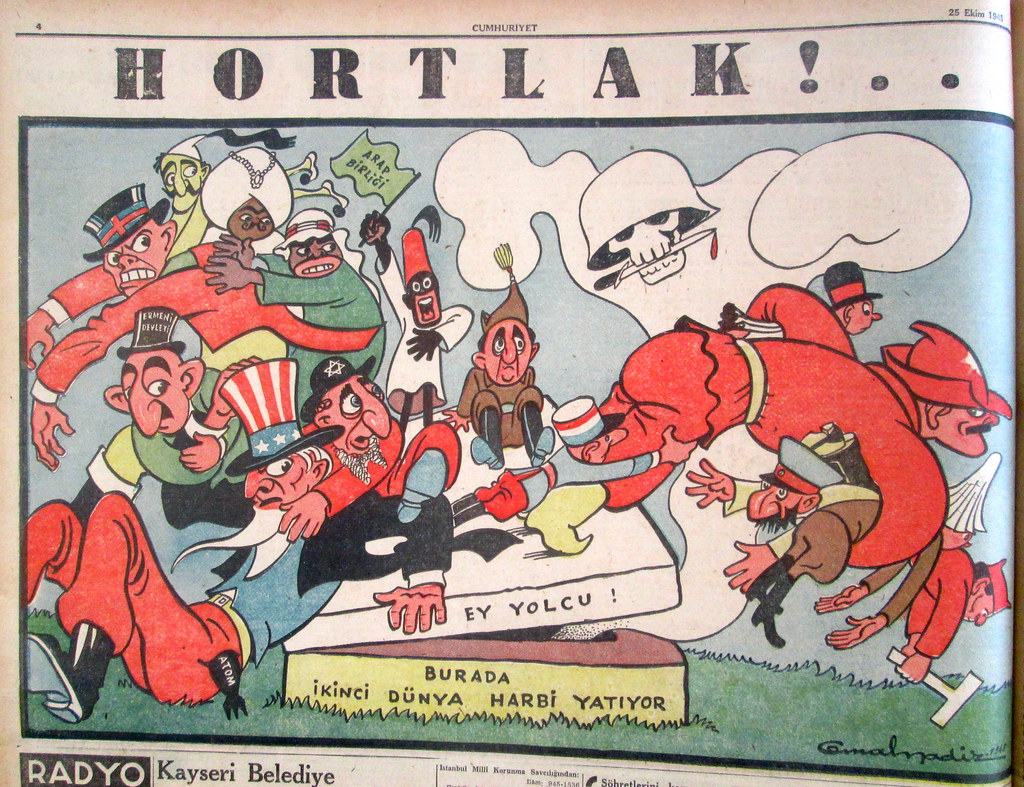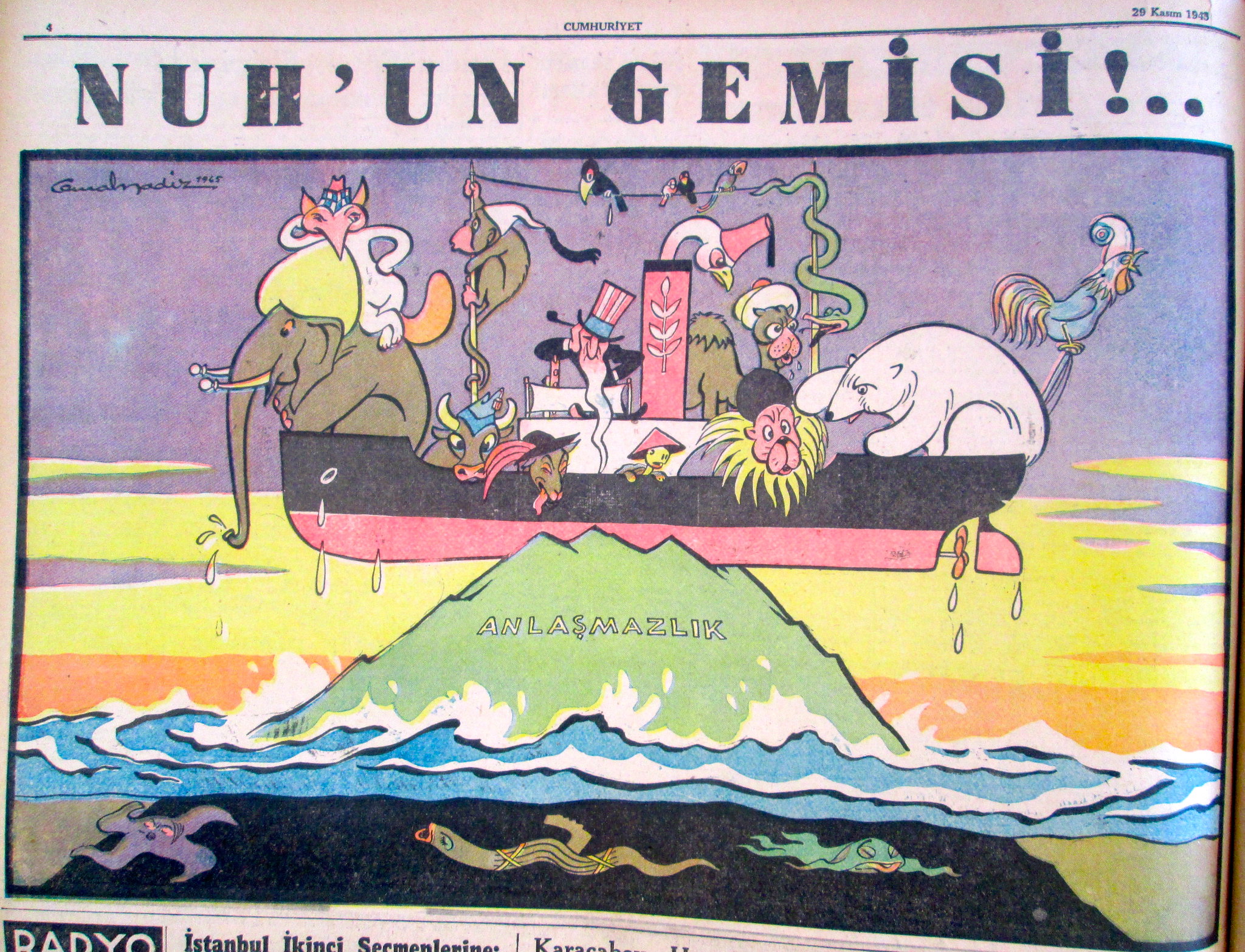With Cumhuriyet's cartoonists back in the news over the past few weeks, we wanted to finally publish an amazing collection of the paper's cartoons that provide a remarkable narrative of the the final years of World War Two. These have been compiled and presented by Irina Levin, Afternoon Map's guest editor and so much more.
As anyone who read our piece on Arabs through Turkish eyes knows, the 1940s and 50s was an amazing era for visually-compelling, if often ideologically problematic, cartoons. Today, courtesy of Irina, we have a remarkable series on World War Two as seen through the cartoons of Cemal Nadir, one of Turkey's most famous illustrators (he has streets named after him in Ankara and Bursa!). These cartoons all appeared in Cumhuriyet. While the paper's editor, Yunus Nadi, received justifiable criticism for his pro-German sympathies during the war, Nadir's cartoons are relatively well-disposed to the Allies, particularly during this period when the war's outcome had become increasingly clear. It is also worth noting how the cartoonist positions Turkey, whose avowed neutrality had frequently been challenged during the course of the conflict. While Soviet Russia (always portly, always in red), England (Churchill, with obligatory cigar), the United States (Uncle Sam or Roosevelt), Germany (Hitler or German soldier), Japan (usually Tojo, in disturbing greenish yellow), and a colorful cast of Europeans (Tito, with a helpful "T" on his face, is easiest to spot!) dominate center stage, Turkey, when it comes in at all, is portrayed as a strong and well-meaning, if minor, player. For instance, in the cartoon entitled "Ümid Dünyası," the Turkish soldier or mehmetcik is pictured dreaming of "domestic and world peace," while the other countries' representatives display more self-serving geopolitical ambitions. In "Sağanak," in which the German soldier is under all-out attack by the Allies, Turkey is represented by a tiny cannon, poised but not actually firing, in the lower right-hand corner.
Nadir's series of cartoons chronicling the war appeared on the back page of Cumhuriyet once a week. Those featured here are highlights from 1944 and 1945, showing Germany's increasingly desperate position and growing US-Russian rivalry, as well as the challenges of decolonization and planning for a post-war world. We've provided translations for the captions (as well as some speculation about the minor characters in weird hats) but the beauty of these cartoons is that they speak for themselves.
As anyone who read our piece on Arabs through Turkish eyes knows, the 1940s and 50s was an amazing era for visually-compelling, if often ideologically problematic, cartoons. Today, courtesy of Irina, we have a remarkable series on World War Two as seen through the cartoons of Cemal Nadir, one of Turkey's most famous illustrators (he has streets named after him in Ankara and Bursa!). These cartoons all appeared in Cumhuriyet. While the paper's editor, Yunus Nadi, received justifiable criticism for his pro-German sympathies during the war, Nadir's cartoons are relatively well-disposed to the Allies, particularly during this period when the war's outcome had become increasingly clear. It is also worth noting how the cartoonist positions Turkey, whose avowed neutrality had frequently been challenged during the course of the conflict. While Soviet Russia (always portly, always in red), England (Churchill, with obligatory cigar), the United States (Uncle Sam or Roosevelt), Germany (Hitler or German soldier), Japan (usually Tojo, in disturbing greenish yellow), and a colorful cast of Europeans (Tito, with a helpful "T" on his face, is easiest to spot!) dominate center stage, Turkey, when it comes in at all, is portrayed as a strong and well-meaning, if minor, player. For instance, in the cartoon entitled "Ümid Dünyası," the Turkish soldier or mehmetcik is pictured dreaming of "domestic and world peace," while the other countries' representatives display more self-serving geopolitical ambitions. In "Sağanak," in which the German soldier is under all-out attack by the Allies, Turkey is represented by a tiny cannon, poised but not actually firing, in the lower right-hand corner.
Nadir's series of cartoons chronicling the war appeared on the back page of Cumhuriyet once a week. Those featured here are highlights from 1944 and 1945, showing Germany's increasingly desperate position and growing US-Russian rivalry, as well as the challenges of decolonization and planning for a post-war world. We've provided translations for the captions (as well as some speculation about the minor characters in weird hats) but the beauty of these cartoons is that they speak for themselves.
Seesaw of Victory
Drowning in a Sea of Rebellion
Downpour (The Dove's message says "Greetings from Tojo")
The Hunter Becomes the Hunted
Cleaning up the Aegean
1944 European Final
Preparing for the Peace Holiday (England and America wash out a number of small European countries, including Greece, with the tassle and mustache, Tito, with the military cap reading T, and France, draped over the edge of the tub. Already hanging up to dry is Italy, far left, Bulgaria, red and green with the mustache, and the Dutch in the wide white cap. The white guy with skis is Finland, but i'm a little unsure about the other Balkan countries with assorted hats. Readers thoughts are welcome.)
Equilibrium
The Cow's Tail (The Carrot reads Facism, the Grass Democracy)
Cooperation: The Stump says "Second World War" and the shoots growing out of it have labels like "Straits Issue, Balkan Issue." Irina adds: "Turtles are never Nazis!"
The World of Hope (Outside a door labelled "Counsel of the Five") Turkey, far right, wants global and domestic peace, Italy wants a dead bird labelled "colonies"and France wants a strong "Western Block." The Libyans want Libya, Tito wants Trieste, Iran wants the British and Russians to leave and Greece just wants a loving brotherly reunion instead of civil war.
Smashup
Camel Wrestling (More on the way Turkey saw the Middle East during this period, with way more racism and anti-semitism, in our article on Arabs through Turkish Eyes.)
One Eats, A Thousand Look On (The Atom Bomb looks good, but check out the bracelet on her hand!)
Good Morning. The man awaking is labelled "Colony" and the Rooster, labelled "Democracy" is crowing "long live independence"
Specter. The tomb is labeled "Here Lies the Second World War" (The Green flag reads "Arab Union" and the guy with the top-hat is labelled Armenian State)
Noah's Ark. The mountain is labelled "disagreement." After everything that happened, this actually seems like a surprisingly optimistic note to end our series on. At least we're all in the same boat?

